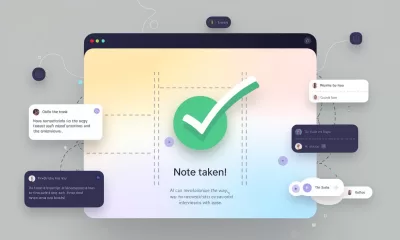Tools
ChatGPT’s Unsettling Advance: Is It Getting Too Smart?
Explore the latest AI advancements in Asia, including ChatGPT’s new capabilities and the ethical considerations surrounding AI development.
Published
6 months agoon
By
AIinAsia
TL;DR:
- ChatGPT’s new capabilities include remembering and reasoning, raising concerns about its intelligence.
- AI pioneer Yoshua Bengio warns about the potential risks of advanced AI models.
- The future of AI in Asia is promising, with innovations and ethical considerations at the forefront.
The Evolution of ChatGPT
Artificial Intelligence (AI) is advancing rapidly, and one of the most talked-about developments is ChatGPT. This chatbot can now remember important details about your day and ask you about them. Recently, a Reddit user named SentuBill reported that ChatGPT asked about his first day of school without being explicitly told. This incident highlights how AI is becoming more human-like, with the ability to reason and remember context from previous conversations.
New Capabilities and Concerns
OpenAI, the company behind ChatGPT, has launched preview versions of its new AI models with enhanced capabilities. These models, codenamed “Strawberry,” can reason and remember information for longer periods. This means ChatGPT can now consider queries in context, making conversations more coherent and less likely to stray from the original point.
However, these advancements have raised concerns among experts. Yoshua Bengio, a renowned AI pioneer and professor of computer science at the University of Montreal, warned that the new GPT models have reached a concerning level of smartness. Bengio’s concerns center on the AI’s ability to reason and potentially deceive, which he believes could be dangerous.
The Future of AI in Asia
Asia is at the forefront of AI and AGI (Artificial General Intelligence) developments. Companies and researchers in the region are pushing the boundaries of what AI can achieve. For example, Alibaba’s AI-powered customer service chatbot, AliMe, has been praised for its ability to handle complex queries and provide personalized recommendations.
Promising Innovations
- Healthcare: AI is being used to diagnose diseases, develop new treatments, and improve patient care.
- Education: AI tutors and personalized learning platforms are helping students achieve better outcomes.
- Transportation: Autonomous vehicles and smart traffic management systems are making cities more efficient and safer.
Ethical Considerations
While the potential benefits of AI are vast, it’s crucial to address the ethical implications. As AI becomes more intelligent, there is a growing need for regulations and guidelines to ensure its safe and responsible use. Bengio’s warnings about the potential risks of advanced AI models underscore the importance of ethical considerations in AI development.
The Role of Memory and Reasoning in AI
The ability to remember and reason is a significant step forward for AI. It allows chatbots like ChatGPT to have more meaningful and contextually relevant conversations. However, this also raises questions about privacy and the potential misuse of AI. As AI becomes more integrated into our daily lives, it’s essential to ensure that it respects user privacy and is used for the benefit of society.
The Impact of AI on Society
AI has the potential to transform society in numerous ways. From improving healthcare to revolutionizing education, the possibilities are endless. However, it’s important to recognize the challenges and risks associated with advanced AI models. As AI becomes more intelligent, there is a need for greater transparency, accountability, and regulation.
Concluding Thoughts: Navigating the AI Landscape
The future of AI is both exciting and uncertain. As ChatGPT and other AI models continue to evolve, it’s crucial to stay informed and engaged in the conversation about their development and use. By addressing the ethical implications and ensuring responsible AI practices, we can harness the power of AI for the benefit of all.
Comment and Share:
What are your thoughts on the future of AI and AGI in Asia? How do you think we can ensure the responsible use of advanced AI models? Share your ideas and experiences in the comments below, and don’t forget to subscribe for updates on AI and AGI developments.
- You may also like:
- Mastering AI: The Future of Work in Asia
- Google’s Med-Gemini Outshines GPT in Clinical Diagnostics
- AI Takes on Math: Google’s Breakthroughs in Reasoning
- To learn more about concerns over AI progress and potential, tap here.
Author
Discover more from AIinASIA
Subscribe to get the latest posts sent to your email.
You may like
-


Can PwC’s new Agent OS Really Make AI Workflows 10x Faster?
-


OpenAI’s New ChatGPT Image Policy: Is AI Moderation Becoming Too Lax?
-


AI Notetakers in Meetings—Innovation, Invasion, or Something in Between?
-


DeepSeek Dilemma: AI Ambitions Collide with South Korean Privacy Safeguards
-


Reality Check: The Surprising Relationship Between AI and Human Perception
-


AI Glossary: All the Terms You Need to Know
Tools
The Secret to Using Generative AI Effectively In 2025
Struggling with genAI? You might be prompting it wrong. Discover the key to getting meaningful results from ChatGPT and other generative AI tools in 2025.
Published
3 days agoon
March 31, 2025By
AIinAsia
TL;DR – What You Need to Know in 30 Seconds
- To get better genAI results, externalise your internal dialogue. This is key for using generative AI effectively.
- Don’t prompt like it’s 2023—ramble with detail for more effective use.
- Treat genAI as a brainstorming partner, not a search engine. Knowing how you’re using generative AI effectively will make a big difference.
Think GenAI Sucks? You’re Probably Using It Wrong.
Do you secretly (or perhaps openly) think generative AI (genAI) sucks? For a while so did I. But using generative AI effectively can change your perception.
Frankly, the early hype around genAI was painful. Remember when ChatGPT exploded in early 2023, and everyone rushed to cram it into their businesses? Those were rough times. Companies, convinced they could instantly replace human talent, laid off skilled workers only to realise later their shiny new AI toys weren’t up to scratch.
Fast-forward to 2025, and the good news is: genAI is finally useful. But there’s a catch—you have to rethink how to use it.
The Surprising Secret: Externalising Your Inner Dialogue
Here’s the thing: genAI doesn’t thrive on short, neat prompts like traditional Google searches. It needs your messy thoughts. In other words, you need to ramble. Learning how to ramble effectively is a part of using generative AI effectively.
Imagine you’re trying to recall that elusive word, the one that perfectly captures a feeling. In Google, you’d agonise over the perfect keyword combo. But with ChatGPT? Just pour out your thoughts:
“What’s the word for a soft feeling that’s warm, but a bit cold? It’s a bit sad, but not quite… you miss something, but you’re glad you miss it. Like walking home from school on a sunny autumn day, knowing winter’s coming and summer’s gone—but you’re happy it happened.”
ChatGPT will understand you’re reaching for “wistful,” or at least point you to it. This kind of rambling, stream-of-consciousness prompting unlocks genAI’s best results.
Why Rambling Works Better Than You Think
To really see genAI shine, do this experiment:
- Open ChatGPT on your phone.
- Tap the microphone button (the one next to the chat box—not the voice chat mode).
- Ramble freely about whatever you’re looking for. Searching for a TV show? Talk about what you like, dislike, your recent binges, random stuff—yes, really random stuff.
- Let your thoughts flow for a minute or two, then hit send without editing. Let the typos, ums, and randomness stay. This method is part of using generative AI effectively.
You’ll get back a response that’s surprisingly on-point. Even better, it’ll suggest avenues you hadn’t considered. Your initial messy prompt becomes a rich context for further exploration.
Back-and-forth Is Your Friend
Say you want the perfect marketing tagline. Start broad, then iterate:
- Get rough ideas first.
- Narrow down based on your reactions.
- Keep steering the conversation with more detailed feedback. This iterative process is crucial for using generative AI effectively.
“I like the third idea, but make it punchier. Number six feels too formal.”
Crucially, you’re still in charge. The AI provides ideas; you provide the judgement. If it strays, simply say, “Not quite right—it’s for a major clothing brand, not a tech startup. Keep it professional but catchy.” The more specific you are, the better it adapts.
AI Productivity Tips: It’s About Co-discovery, Not Automated Decision-making
Think of genAI as your brainstorming partner, not an answer machine. It’s there to surface ideas, connections, and concepts, but you’re still calling the shots. You’re still the one deciding what’s worth pursuing.
Yes, genAI will sometimes hallucinate or miss the mark. That’s fine—just redirect it. Tell it exactly why it’s off-track. The beauty of genAI is its adaptability, not its perfection. Using generative AI effectively involves understanding its limitations and guiding it accordingly.
The Bigger AI Picture: Companies Have Been Selling It Wrong
If you’re sceptical of genAI, that makes sense. The industry’s been pitching it incorrectly, presenting it as a magical decision-maker. No wonder smart people roll their eyes.
GenAI isn’t a replacement for your brain—it’s a tool to extend it. You might still brainstorm traditionally, browse Google, or take long walks to think. Perfect. Generative AI is just another way to spark those insights faster. Ultimately, success depends on using generative AI effectively.
What do YOU think?
Are you ready to stop treating genAI like a vending machine and start chatting with it like a friend?
You may also like:
- GenAI in Asia: 5 Steps to Embrace the Future and Mitigate Risks
- AI Revolution: How AI Creates Equal Learning and Job Opportunities
- Where Can Generative AI Be Used to Drive Strategic Growth?
- Tap here to try this approach on the free version of ChatGTP.
Author
Discover more from AIinASIA
Subscribe to get the latest posts sent to your email.
News
Adobe Jumps into AI Video: Exploring Firefly’s New Video Generator
Explore Adobe Firefly Video Generator for safe, AI-driven video creation from text or images, plus easy integration and flexible subscription plans
Published
2 weeks agoon
March 18, 2025By
AIinAsia
TL;DR – What You Need to Know in 30 Seconds
- Adobe Has Launched a New AI Video Generator: Firefly Video (beta) is now live for anyone who’s signed up for early access, promising safe and licensed content.
- Commercially Safe Creations: The video model is trained only on licensed and public domain content, reducing the headache of potential copyright issues.
- Flexible Usage: You can create 5-second, 1080p clips from text prompts or reference images, add extra effects, and blend seamlessly with Adobe’s other tools.
- Subscription Plans: Ranging from 10 USD to 30 USD per month, you’ll get a certain number of monthly generative credits to play with, along with free cloud storage.
So, What is the Adobe Firefly Video Generator?
If you’ve been keeping an eye on the AI scene, you’ll know it’s bursting with new tools left, right, and centre. But guess who has finally decided to join the party, fashionably late but oh-so-fancy? That’s right — Adobe! The creative software giant has just unveiled its generative AI video tool, Firefly Video Generator. Today, we’re taking a closer look at what it does, why it matters, and whether it’s worth your time.
If you’ve heard whispers about Adobe’s foray into AI, it’s all about Firefly — their suite of AI-driven creative tools. Adobe has now extended Firefly to video, letting you turn text or images into short video clips. At the moment, each clip is around five seconds long in 1080p resolution and spits out an MP4 file.
We’ve got great news — Generate Video (beta) is now available. Powered by the Adobe Firefly Video Model, Generate Video (beta) lets you generate new, commercially safe video clips with the ease of creative AI.
The unique selling point is that Firefly’s videos are trained on licensed and public domain materials, so you can rest easy about copyright concerns. Whether you’re a content creator, a social media guru, or just love dabbling in AI, this tool might be your new favourite playground.
Getting Started: Text-to-Video in a Flash
Interested? Here’s the easiest way in:
- Sign In: Head over to firefly.adobe.com and log in or sign up for an Adobe account.
- Select “Text to Video”: Once logged in, you’ll see a selection of AI tools under the Featured tab. Pick “Text to Video,” and you’re in!
- Craft a Prompt: Type out a description of what you want to see. For best results, Adobe recommends specifying the shot type, character, action, location, and aesthetic — the more detail, the better — up to 175 words.. For example:
Prompt: A futuristic cityscape at sunset with neon lights reflecting off wet pavement. The camera pans over a sleek, silver skyscraper, then zooms in on a group of drones flying in formation, their lights pulsating in sync with the city’s rhythm. The scene transitions to a close-up of a holographic advertisement displaying vibrant, swirling patterns. The video ends with a wide shot of the city, capturing the dynamic interplay of light and technology.
- Generate: Hit that generate button, and watch Firefly do its magic. Stick around on the tab while it’s generating, or else your progress disappears (a bit of a quirk if you ask me).
The end result is a 5-second video clip in MP4 format, complete with 1920 × 1080 resolution. You can’t exactly produce a Hollywood blockbuster here, but for quick, creative clips, it’s pretty handy.
Here’s another one:
A cheerful, pastel-colored cartoon rabbit wearing a pair of oversized sunglasses and a Hawaiian shirt. The rabbit is standing on a sunny beach, surrounded by palm trees and colorful beach balls. As it dances to upbeat music, it starts to juggle three beach balls while spinning around. The camera zooms out to show the rabbit’s shadow growing larger, transforming into a giant beach ball that bounces across the sand. The video ends with the rabbit laughing and winking at the camera.
Image-to-Video: Turn That Pic into Motion
To use this feature, you must have the rights to any third-party images you upload. All images uploaded or content generated must meet our User Guidelines. Access will be revoked for any violation.
If you prefer a visual reference to a text prompt, Firefly also has your back. You can upload an image — presumably one you own the rights to — and let the AI interpret that into video form. As Adobe warns:
Once uploaded, you can tweak the ratio, camera angle, motion, and more to shape your final clip. This is a brilliant feature if you’re working on something that requires a specific style or visual element and you’d like to keep that vibe across different shots.
A Dash of Sparkle: Adding Effects
A neat trick up Adobe’s sleeve is the ability to layer special effects like fire, smoke, dust particles, or water over your footage. The model can generate these elements against a black or green screen, so you can easily apply them as overlays in Premiere Pro or After Effects.
In practical terms, you could generate smoky overlays to give your scene a dramatic flair or sprinkling dust particles for a cinematic vibe. Adobe claims these overlays blend nicely with real-world footage, so that’s a plus for those who want to incorporate subtle special effects into their videos without shelling out for expensive stock footage.
How Much Does Adobe Firefly Cost?
There are two main plans if you decide to adopt Firefly into your daily workflow:
- Adobe Firefly Standard (10 USD/month)
- You get 2,000 monthly generative credits for video and audio, which means you can generate up to 20 five-second videos and translate up to 6 minutes of audio and video.
- Useful for quick clip creation, background experimentation, and playing with different styles in features like Text to Image and Generative Fill.
- Adobe Firefly Pro (30 USD/month)
- This plan offers 7,000 monthly generative credits for video and audio, allowing you to generate up to 70 five-second videos and translate up to 23 minutes of audio and video.
- Great for those looking to storyboard entire projects, produce b-roll, and match audio cues for more complex productions.
Both plans also include 100 GB of cloud storage, so you don’t have to worry too much about hoarding space on your own system. They come in monthly or annual prepaid options, and you can cancel anytime without fees — quite flexible, which is nice.
First Impressions: Late to the Party?
Overall, Firefly’s biggest plus is its library of training data. Because it only uses Adobe-licensed or public domain content, creators can produce videos without fear of accidental infringement. This is a big deal, considering how many generative AI tools out there scrape the web, causing all sorts of copyright drama.
Adobe’s integration with its existing ecosystem is another big draw. If you’re already knee-deep in Premiere Pro and After Effects, having a built-in system for AI-generated overlays, quick b-roll clips, and atmospheric effects might streamline your workflow.
But let’s be honest: the AI video space is already pretty jam-packed. Competitors like Runway, Kling, and Sora from OpenAI have been around for a while, offering equally interesting features. So the question is, does Firefly do anything better or more reliably than the rest? You’ll have to try it out for yourself (and please let us know your thoughts in the comments below).
This sentiment might ring true until Adobe packs in some advanced features or speeds up its render times. However, you can’t knock it until you’ve tried it. Adobe does offer free video generation credits, so have a go. Generate your own videos, add flaming overlays, and see if the results vibe with your style.
Will Adobe’s trusted brand name and integrated workflow features push Firefly Video Generator to the top of the AI video world? Or is this too little, too late?
Ultimately, you’re the judge. The AI video revolution is in full swing, and each platform has its own perks and quirks.
Wrapping Up & Parting Thoughts
Adobe’s Firefly Video Generator is an exciting new player that’s sure to turn heads. If you’re already an Adobe devotee, it makes sense to give it a whirl and see how seamlessly it slides into your existing workflow. You’ll enjoy its straightforward interface, the security of licensed content, and some neat editing options.
But with so many alternatives on the market, is Firefly truly innovative, or just the next step in AI’s unstoppable march through our creative spaces?
Could Adobe’s pedigree and safe licensing edge truly redefine AI video for commercial use, or is the industry already oversaturated with better and bolder solutions?
You may also like:
- Revolutionising the Creative Scene: Adobe’s AI Video Tools Challenge Tech Giants
- Adobe’s GenAI is Revolutionising Music Creation
- Try out the Adobe Firefly Video Generator for free by tapping here
Author
Discover more from AIinASIA
Subscribe to get the latest posts sent to your email.
Tools
Perplexity Deep Research Tool Debuts, Challenging OpenAI and Google
Perplexity AI’s new freemium Deep Research product is shaking up AI, offering lightning-fast, expert-level insights across many industries.
Published
2 months agoon
February 17, 2025By
AIinAsia
TL;DR – What You Need to Know in 30 Seconds
- Freemium Launch: Perplexity AI debuts “Deep Research” with a free tier, challenging pricey AI tools.
- Lightning-Fast: Gathers and summarizes data from dozens of sources in minutes, mimicking a human researcher.
- Strong Performance: Slightly trails OpenAI in some metrics but still outperforms many other AI models.
- Market Disruption: Major funding fuels a direct challenge to Google and OpenAI, despite ongoing legal issues.
- User-Driven Refinement: Encourages feedback to continuously improve accuracy, speed, and reliability.
Introducing the Perplexity Deep Research Tool
Well, folks, the AI research arms race just got a bit more interesting—and a lot more affordable. Perplexity AI has officially unveiled its new “Deep Research” tool, and it’s not just an incremental update. This is a full-on assault on giants like OpenAI and Google, all wrapped up in a lovely freemium bow.
Launched on 15 February 2025, Deep Research is designed to cut your time spent trawling the internet down to mere minutes. Whether you’re investigating market trends in finance, refining marketing campaigns, or just planning your dream holiday, Perplexity aims to do the legwork for you—dozens of searches, hundreds of sources, and a neat summary at the end. And best of all, it’s free for casual use, with a paid tier if you really want to ramp up your daily queries.
Key Features and Capabilities
One of the big selling points Perplexity emphasises is its iterative search and reasoning process, which is meant to mirror the thought process of a human researcher. Here’s the gist of what you get:
- Expert-Level Analysis
Tackles finance, marketing, technology, health, product research, travel planning, and more. Essentially, it’s like having a mini think tank at your disposal. - Automated Deep-Dive
Performs dozens of individual searches, sifts through hundreds of online sources, and draws it all into a comprehensive report. So no more 30-tab chaos in your browser. - Lightning-Fast Turnaround
Delivers results in 2–4 minutes (under three minutes in most cases). Competitors like OpenAI’s Deep Research take 5–30 minutes for complex queries. - Shareable Outputs
Once you get your report, you can export it as a PDF or transform it into a Perplexity Page for easy sharing with colleagues or friends. - Citations for Transparency
Deep Research includes references and citations to its sources, so you can cross-check, trust, or verify any points. Great for academic or professional work where you need that extra layer of credibility. - Iterative Refinement
The system learns as it goes. It reads a chunk, decides what else it needs to look for, and continues to refine its approach until it’s satisfied it has a well-rounded view.
Pricing and Accessibility
According to Perplexity’s own website, the freemium model is turning heads. Here’s the breakdown:
- Free Tier:
Limited to around 5 Deep Research queries per day. Perfect if you just need the occasional deep-dive or want to give it a whirl before upgrading. - Pro Subscribers ($20/month):
Access to 500 daily queries, a huge jump in usage allowance. That’s significantly undercutting some major players, like OpenAI’s $200/month plan.
In comparison to enterprise-level AI research tools (which can run up to $75,000 per month), Perplexity is practically handing out advanced AI research on a silver platter, at least from a cost perspective. The company’s strategy here seems to be a combination of “democratise AI research” and “force the big boys to rethink their pricing.”
Performance Benchmarks
Alright, so how does Deep Research stack up under the hood? Let’s get to the numbers:
- Humanity’s Last Exam:
- Perplexity’s Deep Research: 21.1%
- OpenAI’s Deep Research: 26.6%
- Google’s Gemini Thinking: 6.2%
- Grok-2: 3.8%
- GPT-4o: 3.3%
- While Perplexity lags a bit behind OpenAI’s top-tier offering, it beats other well-known AI models by a fair margin.
- SimpleQA Benchmark:
- Perplexity’s Deep Research: 93.9% accuracy
So, yes, it’s not absolutely top of the tree on some metrics, but it’s definitely competitive—and far ahead of many alternatives.
Market Impact and Competition
This move puts Perplexity squarely on a collision course with OpenAI and Google, who’ve been jockeying for position in the advanced AI research space. It’s worth noting:
- Company Growth:
Perplexity was founded in 2022 by ex-OpenAI researcher Aravind Srinivas. Rapid expansions, plus a $500 million funding round last December, have given it a staggering $9 billion valuation. Investors include heavyweights like Jeff Bezos and Nvidia. - Legal Hurdles:
Perplexity is currently wrestling lawsuits from some media organisations over alleged unauthorised use of copyrighted articles. They’re seeking to mollify publishers with collaboration deals and revenue-sharing agreements, signing the likes of Time and Fortune. - Competition:
Google is well-established, and OpenAI has name-brand recognition plus GPT’s massive user base, but Perplexity’s “high-value, low-price” approach could disrupt the market if it continues to deliver on speed and research depth.
Challenges and Future Outlook
Despite the buzz, Perplexity’s Deep Research isn’t without its pitfalls:
- Accuracy vs Speed
While 21.1% on Humanity’s Last Exam is solid, it’s still below OpenAI’s 26.6%. Perplexity’s big claim is that it outdoes many rivals on speed. But for critical, expert-level tasks, some users may still lean towards the highest possible accuracy. - Ethical Concerns
Like all AI research tools, there are worries about diminishing human critical thinking and potential reliance on “fast” answers over “deeply validated” insights. That’s an industry-wide conversation that won’t end soon. - Ongoing Lawsuits
The legal back-and-forth with major media outlets is no small matter. To remain fully legit (and maintain public trust), Perplexity will likely have to sign more licensing deals or refine how it sources content. - User Trust and Adoption
Breaking into a space dominated by OpenAI and Google is no walk in the park. Even if their product is fantastic, Perplexity needs to keep scaling its user base while handling the stress test that a wave of new users can bring.
Despite these challenges, Perplexity is forging ahead with expansions to iOS, Android, and Mac platforms, as well as continued refinement of its models. If they strike the right balance between accessibility, accuracy, and cost, there’s a good chance they can secure a sizeable share of the AI research pie.
Why Speed and Cost Matter in AI Research
The AI research sphere is going through a bit of a metamorphosis: big enterprise solutions can cost tens of thousands per month, yet more and more small businesses, freelancers, and academics also want access to advanced AI. By offering a freemium tier that performs at a near-competitive level with top-tier solutions, Perplexity is effectively lowering the barrier to entry for advanced research.
And speed? If you can get a comprehensive, properly cited report in 3 minutes rather than 30, that’s a massive productivity win. For time-critical fields like finance, health, or real-time marketing campaigns, it can be the difference between making the right call or missing an opportunity.
Potential Applications Across Industries
Perplexity is keen to emphasize how Deep Research can handle multiple verticals:
- Finance: Collating market data, generating forecasts, and providing real-time financial analysis.
- Marketing: Performing competitor analysis, consumer behavior insights, and strategic planning.
- Technology: Deep dives into emerging tech trends, algorithmic benchmarks, and scoping out R&D projects.
- Health: Acting as a personal consultant for health and wellness research (with obvious caveats that it’s not a medical professional!).
- Travel Planning: From recommending itineraries to budgeting and flight/hotel comparisons.
- Product Research: Assessing product features, user sentiment, and market viability.
Essentially, if you need to wade through lots of data quickly, Deep Research might be your new best mate.
Accuracy, Trust, and User Feedback
Ensuring Accuracy
How does Perplexity aim to keep the nonsense and hallucinations to a minimum? They rely on a variety of strategies:
- Searching Hundreds of Sources
It’s all about cross-referencing. If 90% of sources say “X,” the final answer probably leans that way. - Trust-Based Ranking
A PageRank-esque system that looks at source credibility, giving more weight to, say, reputable news outlets over random forums. - Ongoing User Feedback
Perhaps the most crucial: they allow users to flag dodgy info or provide improvements, using that data to retrain and refine the model.
Feedback Loop
Perplexity encourages a user-driven improvement cycle. Types of feedback they actively seek:
- Accuracy Assessment: Point out any wrong or outdated info.
- Source Quality: Let them know if a chosen source is questionable or irrelevant.
- Comprehensive Coverage: Tell them if the final report missed a critical subtopic.
- User Experience: Interface or design tweaks that could smooth out the workflow.
- Domain-Specific Nuances: For fields like finance or health, domain experts can highlight deeper complexities to refine the AI’s output.
This iterative approach helps Perplexity calibrate its models over time, building a more reliable system that better meets user expectations.
Final Thoughts
So there you have it—Perplexity’s Deep Research is here, and it’s looking to shake up the AI research market by delivering swift, thorough, and fairly accurate results without the punishing subscription fees of some competitors. While it may not quite surpass OpenAI’s top-tier solution in raw accuracy, it’s coming close enough for most everyday use cases—and, in some respects, it’s leaving everyone else in the dust.
The company’s growth, ambitious partnerships, and willingness to face legal and ethical questions head-on show that Perplexity is more than a flash in the pan. If you’re in finance, marketing, or tech, or simply a curious researcher wanting a user-friendly, budget-friendly AI tool, you might want to take Deep Research for a spin. It’s free, after all, so why not?
One thing’s for sure: with market leaders being nudged by smaller but nimble players like Perplexity, the AI research landscape will only get more interesting—and more competitive. Watch this space.
What do YOU think?
Will Perplexity’s freemium ‘Deep Research’ tool be the breakthrough that finally topples AI giants like OpenAI and Google, or is this just a temporary shake-up in an ever-evolving battlefield? Let us know in the comments below.
You may also like:
- Perplexity Assistant: The New AI Contender Taking on ChatGPT and Gemini
- Perplexity Introduces Pages: The Newest AI Article Generator
- Can Singtel’s Free Access to Perplexity Pro Redefine AI Search?
- Or try out Perplexity AI for free by tapping here.
Author
Discover more from AIinASIA
Subscribe to get the latest posts sent to your email.

Embrace AI or Face Replacement—Grab CEO Anthony Tan’s Stark Warning

Can PwC’s new Agent OS Really Make AI Workflows 10x Faster?

The Secret to Using Generative AI Effectively In 2025
Trending
-

 Life4 days ago
Life4 days agoAI-pril Fools! How AI is Outsmarting Our Best Pranks
-

 News2 weeks ago
News2 weeks agoAdobe Jumps into AI Video: Exploring Firefly’s New Video Generator
-

 News4 days ago
News4 days agoOpenAI’s New ChatGPT Image Policy: Is AI Moderation Becoming Too Lax?
-

 Business2 days ago
Business2 days agoCan PwC’s new Agent OS Really Make AI Workflows 10x Faster?
-

 Tools3 days ago
Tools3 days agoThe Secret to Using Generative AI Effectively In 2025
-

 Business1 week ago
Business1 week agoForget the panic: AI Isn’t Here to Replace Us—It’s Here to Elevate Our Roles
-

 News1 week ago
News1 week agoGoogle’s Gemini AI is Coming to Your Chrome Browser — Here’s the Inside Scoop
-

 News1 week ago
News1 week agoTencent Joins China’s AI Race with New T1 Reasoning Model Launch




























